Signing In to Microsoft Windows 8
![]() The articles about logging on and off of Microsoft Windows have been among the most popular in the J.D. Fox Micro Resource Center. While the original articles covered every recent version of Windows, Windows 8 brought enough changes that an entirely new series of articles was necessary. Any reference to Windows 8 in this article applies to both Windows 8 and Windows 8.1.
The articles about logging on and off of Microsoft Windows have been among the most popular in the J.D. Fox Micro Resource Center. While the original articles covered every recent version of Windows, Windows 8 brought enough changes that an entirely new series of articles was necessary. Any reference to Windows 8 in this article applies to both Windows 8 and Windows 8.1.
![]()
![]()
![]() Click here for the edition of this article for Windows 7 and earlier.
Click here for the edition of this article for Windows 7 and earlier.
Introduction
As you know, you have to log on to your Windows computer or tablet every time you start it up. You either type or click on your user name, and then type your password. This is how you identify yourself to your computer in a secure manner, so it can load your personalized settings and give you access to the programs and files you're allowed to use.
For Windows 8, released in 2012, Microsoft introduced the most significant redesign of the desktop since Windows 95. This was done primarily to better support tablets with small screens running at high resolution which have proliferated recently, and for easier navigation using your finger rather than a mouse.
The process of logging on is different as well. First, Microsoft now always uses the term sign in, after having used log on for at least 22 years. Beyond just the terminology, Windows now no longer requires you to press Ctrl+Alt+Delete by default to open the sign in screen. Again, this is to better support tablets with no keyboard. In addition, you can now connect a Microsoft account to your computer, and sign in using that, to seamlessly access any files you have stored in Microsoft's online file storage service, OneDrive (formerly called SkyDrive), access Microsoft application software subscriptions such as Office 365, and get your Internet Explorer favorites and other settings that you have shared among multiple devices.
This article covers some basics about signing in, how to deal with common problems when signing in, and some extra considerations when using Remote Desktop.
For highly secure networks, your company may issue smart cards for signing in instead of assigning you a user name and password; instead of typing your name, you select your name after inserting your smart card, and type a numeric PIN instead of a password. Since most networks do not use smart cards, this article only covers standard user names and passwords. But the procedures, and typical problems you might have, are mostly the same.
How to Log On
To get started, click or tap the screen, which by default looks like the images below on a generic system. Some computer manufacturers might use their own screens to promote their brand, or, if you're on a business network, your system administrator might customize the screen.
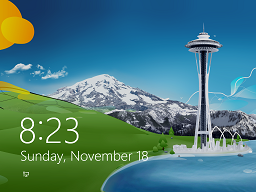
Windows 8
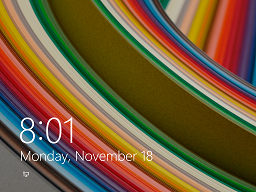
Windows 8.1
Windows 8
Windows 8.1
You will then see at least two tiles: One shows the full name and logon name of the last person to sign in, while the one labeled Other user is for everyone else to use. Displaying users' full names on the sign-in screen is new for Windows 8, by the way. Click or tap the appropriate tile.
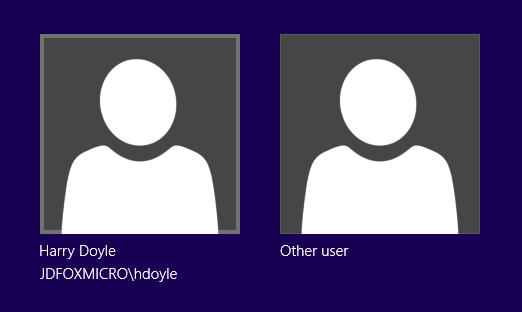
If you click or tap your own name, you will see this, and you can type your password:
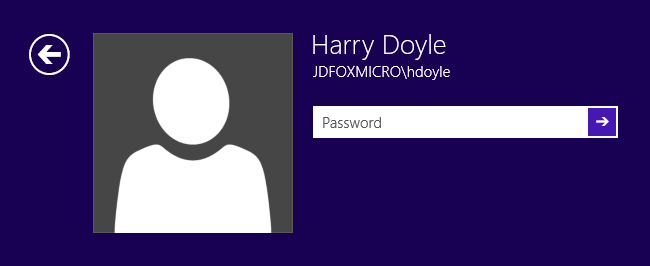
If you instead click or tap Other user, you will see the screen below, which allows you to type in your user name as well as your password.
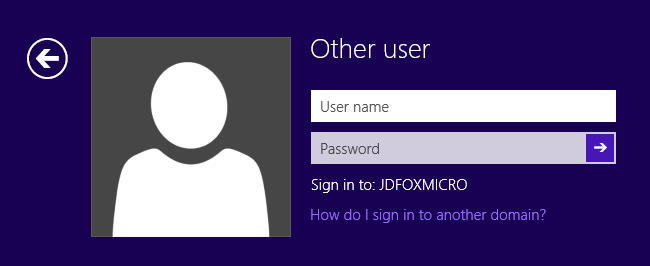
Windows 8, like the two previous versions of Windows, allow multiple users to be signed in to the same computer at once (see the article on Signing out of Windows for more information about this). If anyone is signed in already, you will see tiles for all the users that are signed in, which might look something like this:

If you're signed in already, you can click or tap the tile for your account, enter your password, and get back in to your active sign-in session. If not, you can still click Other user and sign in with your account.
By the way, the white silhouette is the default image for all user accounts in Windows 8. To change yours, click or tap your name on the Start screen, and choose Change account picture.
Problems Signing In
The most common problem you will have when signing in is that the password is wrong. When this happens, you will see a message like one of the two below.
When you clicked or tapped your name:
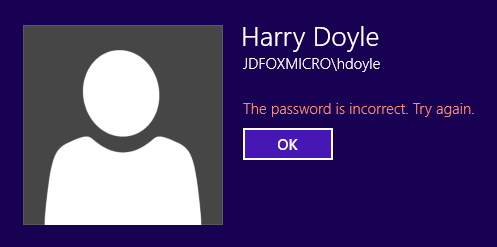
Or if you selected Other user and typed both your name and password:
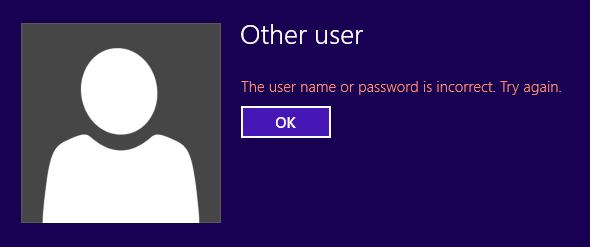
If you see a message that your account has been disabled or that "no logon servers are available", then your problem has nothing to do with your user name or password, and you should contact your system administrator for help.
Wrong Password
Many users think there is a problem with their account and call for help, but they are simply typing the password wrong. This is more likely to happen on a Monday (seriously!).
But, it is not always that the password happened to slip your mind. There are other causes, such as a sticky key on the keyboard or a "fat finger". Or, the Caps Lock might be enabled. Since your Windows password is case-sensitive, typing it with Caps Lock will mean you're typing it wrong, but you can't tell because you can't see what you're typing. If Caps Lock is on, Windows will tell you on the sign in screen. If you see this, tap the Caps Lock key to turn it off.
A similar problem can occur if you use the number pad on the right side of your keyboard when you have digits in your password. If the Number Lock is not enabled, keypresses on the number pad won't be registered. It's not always easy to tell if the Number Lock is enabled, and Windows doesn't detect it either; so, to avoid this problem, get in the habit of always using the number keys that run horizontally above the letters on your keyboard for typing passwords.
One nice new feature of Windows 8 is that, although it obscures your password as you type it to prevent bystanders from seeing what you're typing, you can now peek at it by clicking or tapping this little icon  after you type your password. Use this if you aren't sure you're typing the password right because of the Caps Lock, Number Lock or possibly a bad key on your keyboard.
after you type your password. Use this if you aren't sure you're typing the password right because of the Caps Lock, Number Lock or possibly a bad key on your keyboard.
Sometimes it's not a typo or keyboard problem; you might simply have gotten your Windows password mixed up with the password for something else. Many users run various programs and access several websites that they must log on to throughout the day. Examples include a specialized billing application, customer management software, web-based e-mail, or a password-protected QuickBooks file. If this sounds like your situation, consider whether you have absent-mindedly typed the password for something else when having problems logging on to Windows.
Finally, you might be typing the wrong password through no fault of your own, because an IT system administrator changed your password overnight. If an IT system administrator needs to sign in to your computer using your account (for example, to test a new application or fix a problem particular to your user account), and you've already left for the day, he will change your password first to whatever he wants, then use that to sign in as you. This is because there is no mechanism for anyone, even an administrator, to see what your password is. Of course, a good administrator will notify you in advance that he's going to change your password, instead of relying on your calling the Help Desk when you come in the next morning and find you can't sign in. But, there are sloppy administrators out there.
Wrong User Name
In versions of Windows prior to Windows 8, the last user's name always appears on the logon screen with the cursor already in the password box. So, if you are the last one to use such a computer, you can always log on by just smacking Ctrl+Alt+Delete and typing your password. This causes problems when someone else logs on to a computer that normally only you ever use, and you don't notice another user's name is in the box. Very often people call for support when they can't sign in, without even thinking to check the user name. Even worse, in this situation, some users discover they don't even know what their user name is!
Starting with Windows 8, the sign-in screen no longer selects the previous user automatically for you. While the last user's name is displayed, it's shown in a tile alongside the Other user tile, and you must click or tap one or the other before you can type your password. Because of this, you are much less likely to find yourself entering the correct password but for the wrong user.
Additional Notes
Still, some users don't know their user name or password because they leave their computer signed in day after day. That's fine until the power goes out or your computer crashes and reboots, or someone else signs you off. If this might be you, take a moment now to be sure you know your user name and password. If you're not sure, be sure you have access to a support provider or your system administrator before you sign off and test it!
If you're observant, you might have noticed that the user names above were preceded by a domain name JDFOXMICRO. On virtually all networks, selecting the correct domain will not be an issue. However, if you'd like, click here to read the article about domains and their role in signing in.
Remote Desktop
You can use Remote Desktop to sign in to your Windows 8 computer from another computer across your office network or over the Internet, if your IT system administrator has enabled the capability.
If no one is signed in to the remote computer, then you can sign in remotely just by typing your user name and password like normal. If you left your account signed in to the office computer, then when you connect from home using Remote Desktop, the active sign-in session will simply switch to the Remote Desktop window on your home computer, with everything open exactly you left it. To anyone at the office who looks at your computer screen there, it will appear no one is logged on, providing you with privacy.
Only one person can be actively signed in to a Windows 8 computer at a time. So if you try to sign in to a computer using Remote Desktop and someone else is already signed in using a different account, both users will see see alert messages about what the other is doing.
Here's how it works. Let's say your name is Del Griffith. If you use a computer at home (or a laptop or tablet while travelling) to try to sign in using Remote Desktop to a computer at your office, and user Neal Page is already using it, then you will first see this message on your home computer:
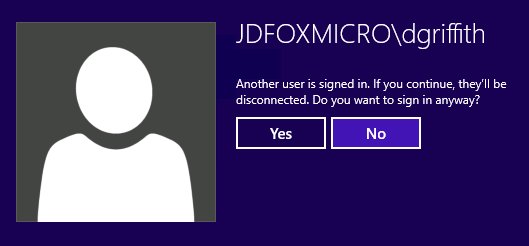
Note that it shows you your own sign-in name, but doesn't show you who it is that's signed in already. Anyway, if you choose to continue, then this message will pop up on Neal's screen at the office:

while your computer asks you to wait for Neal to respond. If he clicks OK or just isn't around, you will get in. Either way, all of Neal's programs and files will stay open in a separate suspended sign-in session.
If Neal instead clicks Cancel on the prompt above, then your sign-in attempt will be blocked.
Once you're signed in to your office computer from home, then to anyone sitting at the computer at the office, it will appear at first as if no one is signed in. If Neal tries to sign back in, he will get the same warning that you did, saying that someone else is signed in.
If he clicks Yes to confirm he wants to disconnect you, then you will now get the exact same message he did when you tried to connect, this time asking you if he can connect. If you allow him to connect, he will regain access to his sign-in session; you will be disconnected, but your programs and files will remain open. You will then see this message on your home computer:

You would also see this if you were away from your computer, and Neal was able to connect because you didn't respond to the request. Despite the wording making it seem like there's some sort of problem, it's actually an ordinary event, as you have learned. If you really have a problem, you could best solve it by calling Neal to find out when he's going to be done, rather than bugging your network administrator!
Read articles about related topics: